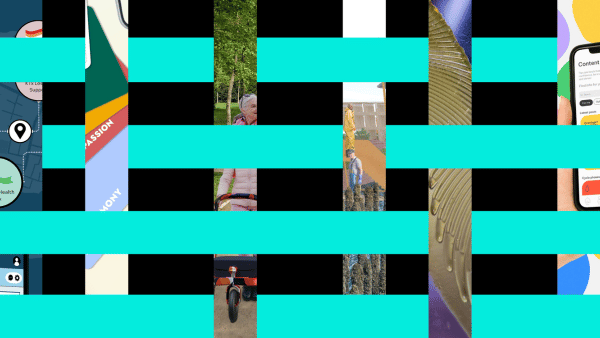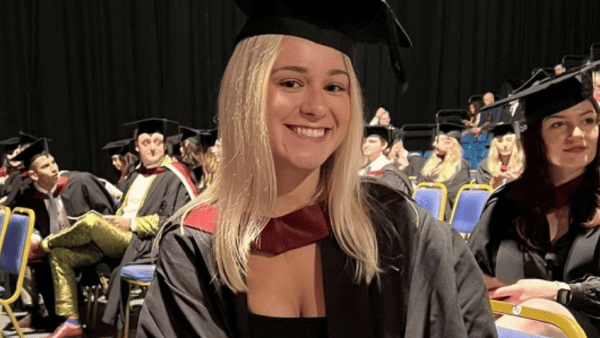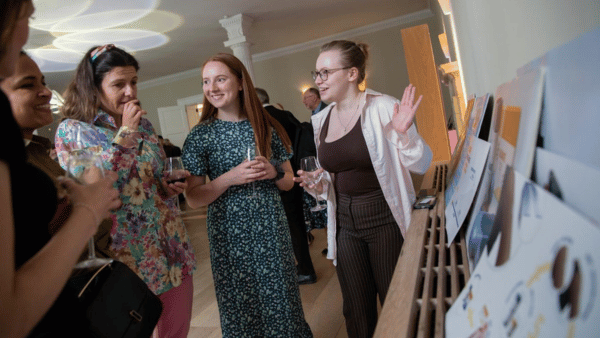Having been a judge of the RSA Student Design Awards, Russell Beard FRSA shares some of his insights, the things that have impressed him and – in no particular order – his thoughts on how things are changing.
This year was my fourth year of judging the RSA Student Design Awards. Once as a senior designer who was standing in for my boss at the last minute back in 2004, twice as a previous sponsor and co-author of the brief, and this year simply as an independent panel judge.
In truth, the first time I did it, I was ambushed; I did not really know what to expect but thoroughly enjoyed it. To be honest, the second time, in 2017, it was something I came to inherit as a Head of Design at Kinneir Dufort and hadn’t really been entirely cognizant of. However, that second stint of a few years really made me aware of the impact and far reaching benefits of the Awards and how much they do to really give individuals the chance to rocket boost their confidence.
That is why, after a break of two years, I was keen as mustard to return to the Awards and do what I could to support and contribute, as part of my endeavours to help those at the earliest points in the creative careers. Having seen the judging from a few angles and hundreds upon hundreds of submissions, I thought I would provide some observations for those that know little of the Awards or for those that may wish to know more.
Global input
When you review the submissions as a judge, each board has no indication of the student’s country of study, gender or cultural background. In fact we know nothing about them. What we are presented with is simply a series of six boards with a design proposition explained accordingly. I do try and see if I can guess where the student studies, but I invariably get it wrong. When the list is published and names revealed of the final shortlisted students (which we have all scored ‘blind’), I am always astonished at the global representation in the students who have submitted. For sure, there are large proportions of the submissions that come from UK based universities (as you would expect), but I absolutely love the fact that there are entries from India, Canada, Singapore, Brazil, America, and many, many more. I particularly love the fact that the RSA shows no preference to anyone. Submit an entry and it will be judged as fairly as it possibly can be, against any other entry from anywhere else in the world. In fact, with all judging and interviews now conducted via video conference, there is literally no barrier to submission and this year, that breadth and volume of global submissions was clearly evident.
Judging eclecticism
I have loved each panel of judges I have had the privilege to work with. They have all been incredibly humble, creative, honourable and insightful creatures. But in past years, they have typically had to be drawn from a pool of people able to schlep it to RSA House in London on a series of key dates. Whilst this yields an amazing pool of talent, it is not always representative of the wider creative and professional community at large.
This year, however, was a breath of fresh, globally expansive air. In one call, we had representation from the UK, Thailand, Canada and Brazil, and even the UK contingent was as far spread as you could imagine (from Dundee to the Cotswolds). These judges were not only cast far and wide, meaning experiences, outlooks and attitudes vastly differed, but also the breadth of raw experience, academic prowess (I count myself at the lower end of this spectrum) and interpretation of creativity meant that shortlisted candidates were judged by a truly balanced, globally representative panel of experts. I often found myself feeling like an imposter but thoroughly appreciated everyone’s different points of view. It was amazing and personally rewarding to be a part of something so culturally and globally far reaching.
Selflessness
Each of the judges genuinely seems to want to be there for one purpose alone: to support the awards and the students. There is no tussle for attention or the self-obsessed vanity that you might expect of a design award panel; just a bunch of experienced people from different backgrounds, spending plenty of time, passionately discussing the virtues (or lack thereof) of different student submissions. Everyone invests fully in the process, and respects the other judges’ views to the point, where on multiple occasions, opinions were entirely voluntarily overturned after hearing a different point of view from a fellow judge. It is not a bunch of individuals fighting for their favourite submission, but a panel of people actively discussing the pros and cons of a creative solution, bringing to bear all of their individual knowledge and expertise in a selfless way to facilitate a fair and even judging process. This is as it should be.
Jealousy
It is very easy as seasoned professionals to sit and bear judgement on a creative submission. We’ve been around the block a few times and have the confidence to understand what is required of a design solution. Take me back to when I was 21 – the typical age of an RSA entrant – and I would not have been half as capable as some of the candidates we see. Notwithstanding the independent calibre of the work, I am always astounded by how professional, engaging and knowledgeable the shortlisted interviewees are. Faced with a panel of six intimidating (we try not to be) and experienced professionals who know their onions, I would be a wreck, but these young people ace it. For sure there are nerves and some work is better than others, but on the whole I am incredibly encouraged by the future of the creative industries if these students are any measure of the standard across the board. I always take great pleasure in following the individual careers of many of those I have met over the years and it is so gratifying when you see them rise – justifiably – and impress to become influential in their own right.
Big stuff
The thing that strikes you about the RSA Student briefs is the scale of the problems that a student can choose to tackle. These are big issues. In our specific case, it was the right to clean air; a fundamental human right. Ultimately, it is down to each individual student to interpret the brief as they see fit, but the bandwidth of solutions is awe inspiring. From the immediate, practical solutions that deal with micro-issues to the fantastical, crazy dreams of the future, every single one of them attempts to tackle these big issues in their own characterful and innovative way.
But remember, the judging criteria are brutal. Not only do ideas need to demonstrate creativity, but also they have to be rooted in research, understanding, application, systems thinking and an understanding of practicality and implementation. You cannot just sketch the moon on a stick and take a step back. It is often easy to dismiss these submissions as ‘just’ student work, but the combined resource of innovative thinking and sheer brain hours on a given subject that is important to all of humanity is quite phenomenal and should not be underestimated.
Polymathy
Each time I judge the RSA awards, I am astonished when I see the final shortlisted interviewees and correlate their submissions to their undergraduate course or area of study. In times past, you could tell an industrial design student submission from a graphic design student submission from a fashion design student submission. Now it’s anyone’s game. Whilst there are still submissions that clearly root themselves and the output in their specialist subject, what is striking from those that get to interview, is the breadth and application of thinking and the aptitude to leap from digital to physical, understand behaviour and engineering, deal with big systems architecture and small micro-interactions simultaneously and all whilst telling a compelling story across six simple A3 boards. Whilst these students are all at the start of their career journeys, it certainly makes you think about the organic nature of problem solving and the lanehopping, polymathic role of designers in our society. It is no wonder that we often struggle to define design concisely when it can morph and mutate to cover pretty much every aspect of problem solving and human behaviour so fluidly. Award participants represent that fluidity in spades.
Covid-19 creativity
One thing that was very apparent this year was the effect that the pandemic has had on submissions. Given that one of the five judging criteria scores “rigorous research and compelling insights”, it was interesting to see how students had tackled this whilst confined to barracks under lockdown (one thing we can thank Covid-19 for is that it kept the playing field level by affecting everyone globally).
Consideration was given to the need to rely a little more on secondary research where primary was almost impossible to secure, but it was heart-warming to see the innovative ways that students had found ways around these issues and unearthed unpredictable insights and behavioural nuggets of wisdom. One student had even managed to set up FaceTime interviews with rural Thai farmers from his student accommodation in the UK, all by tenaciously following gossamer thin threads of opportunity until he found what he needed to inform his solution. He didn’t just Google it and watch archived YouTube newsreels, but found his way to the source, by hook or by crook. Bravo.
It still baffles me why more businesses do not support these RSA Student awards. Notwithstanding the work from the students and the sheer value it can provide to your business as the deepest, richest pool of ideas, it should be our obligation to ensure that young, aspiring, tenacious creative talent is fed, watered and promoted to ensure that our society pushes the best thinkers, doers, changemakers and collaborators as far as possible. This is in all of our interests. Not providing support is like neglecting plant crops and then looking surprised when there’s no food on the table to eat.
Business support is even more important now, as the problems our planet and society faces are knotty, complex, multi-modal, systemic problems that require people with agile brains and lane hopping prowess to navigate. The kinds of people that enter the RSA Design Awards need our encouragement to prosper and mature.
Russell has spent 25 years working in coal face product design consultancy across the spectrum of healthcare, branded FMCG, industrial and technology. He now works as a mentor, educator and creative consultant under the FourBeards brand.
Related content
-
Student Design Awards 2024: meet the shortlist
News
Aoife O'Doherty
The RSA Student Design Awards 2023 shortlist has been announced. Across nine briefs, 70 students are working to bring positive social change to people, place and planet.
-
Sophie Hague: me and my education
Blog
Sophie Hague
Sophie Hague, a 2022 Student Design Award winner, explains how design helped to identify the learning techniques that worked for her.
-
The Student Design Awards' most ambitious year yet
Blog
Anna Markland
Learn about our legacy of active inclusion and our commitment to making 2023-24 the boldest and most far-reaching Pupil and Student Design Awards cycles yet.




Be the first to write a comment
Comments
Please login to post a comment or reply
Don't have an account? Click here to register.